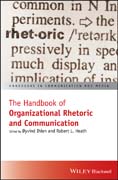
The Handbook of Organizational Rhetoric and Communication
Ihlen, Oyvind
Heath, Robert L.
A one–stop source for scholars and advanced students who want to get the latest and best overview and discussion of how organizations use rhetoric While the disciplinary study of rhetoric is alive and well, there has been curiously little specific interest in the rhetoric of organizations. This book seeks to remedy that omission. It presents a research collection created by the insights of leading scholars on rhetoric and organizations while discussing state–of–the–art insights from disciplines that have and will continue to use rhetoric. Beginning with an introduction to the topic, The Handbook of Organizational Rhetoric and Communication offers coverage of the foundations and macro–contexts of rhetoric as well as its use in organizational communication, public relations, marketing, management and organization theory. It then looks at intellectual and moral foundations without which rhetoric could not have occurred, discussing key concepts in rhetorical theory. The book then goes on to analyze the processes of rhetoric and the challenges and strategies involved. A section is also devoted to discussing rhetorical areas or genres namely contextual application of rhetoric and the challenges that arise, such as strategic issues for management and corporate social responsibility. The final part seeks to answer questions about the book s contribution to the understanding of organizational rhetoric. It also examines what perspectives are lacking, and what the future might hold for the study of organizational rhetoric. Examines the advantages and perils of organizations that seek to project their voices in order to shape society to their benefits Contains chapters working in the tradition of rhetorical criticism that ask whether organizations rhetorical strategies have fulfilled their organizational and societal value Discusses the importance of obvious, traditional, nuanced, and critically valued strategies such as rhetorical interaction in ways that benefit discourse Explores the potential, risks, paradoxes, and requirements of engagement Reflects the views of a team of scholars from across the globe Features contributions from organization–centered fields such as organizational communication, public relations, marketing, management, and organization theory The Handbook of Organizational Rhetoric and Communication will be an ideal resource for advanced undergraduate students, graduate students, and scholars studying organizational communications, public relations, management, and rhetoric. INDICE: List of Figures ix .List of Tables and Boxes xi .Notes on Contributors xiii .Preface xxi .Part I Introduction 1 .1. Introduction: Organizational Rhetoric 3Øyvind Ihlen and Robert L. Heath .Part II Field Overviews: Foundations and Macro ]Contexts 15 .2. Organizational Communication and Organizational Rhetoric I: The Theme of Merger 17Charles Conrad and George Cheney .3. Organizational Communication and Organizational Rhetoric II: The Theme of Division 33Charles Conrad and George Cheney .4. Public Relations and Rhetoric: Conflict and Concurrence 51Robert L. Heath and Øyvind Ihlen .5. Marketing Rhetoric and the Rhetoric of Marketing: Manipulation or Mutuality? 67Simon Møberg Torp and Lars Pynt Andersen .6. Rhetorical Analysis in Management and Organizational Research, 2007 2017 81Larry D. Browning and E. Johanna Hartelius .7. A Theory of Organization as a Context For, and as Constituted by, Rhetoric 95John A.A. Sillince and Benjamin D. Golant .Part III Concepts: Foundations Without Which Rhetoric Could Not Occur 111 .8. Identification: Connection and Division in Organizational Rhetoric and Communication 113Robert L. Heath, George Cheney, and Øyvind Ihlen .9. Deploying the Topics 127Greg Leichty .10. The Truth About Ideographs: Progress Toward Understanding and Critique 143Josh Boyd .11. Myths that Work: Toward a Mythology of Organizations and Organizing 155Graham Sewell .12. Stasis Theory: An Approach to Clarifying Issues and Developing Responses 169Charles Marsh .13. Corporate Apologia: Organizational Rhetoric and Wrongdoing 185Keith M. Hearit .14. Ethos and its Constitutive Role in Organizational Rhetoric 201James S. Baumlin and Peter L. Scisco .15. The New Civic Persona: Organizational/Institutional Citizenship Reimagined 215Jill J. McMillan, Katy J. Harriger, Christy M. Buchanan, and Stephanie Gusler .16. Rhetorical Figures: The Case of Advertising 229Bruce A. Huhmann .17. Spades, Shovels, and Backhoes: Unearthing Metaphors in Organizational Rhetoric 245Damion Waymer .18. Synecdoche: Another Ubiquitous and Everyday Trope 257Peter M. Hamilton .Part IV Processes: Challenges and Strategies 269 .19. Rhetorical Legitimacy Contests: EpiPen and the Pharmaceutical Industry s Rope ]A ]Dope 271Ashli Q. Stokes .20. Rhetorical Agency: What Enables and Restrains the Power of Speech? 287Elisabeth Hoff ]Clausen .21. Organizational Rhetoric in Deeply Pluralistic Societies: The Agonistic Alternative 301Scott Davidson .22. Understanding the Rhetoric of Dialogue and the Dialogue of Rhetoric 315Michael L. Kent and Maureen Taylor .23. Persuasion in Organizational Rhetoric: Distinguishing between Instrumental and Deliberative Approaches 329Ford Shanahan, Alison Vogelaar, and Peter Seele .24. Strategic Message Design Defined: A Call for Focused Organizational Rhetoric and Communication 345Pete M. Smudde and Jeffrey L. Courtright .25. Visual and Multimodal Rhetoric and Argumentation in Organizations and Organizational Theory 359Jens E. Kjeldsen .26. Conceptualizing Audience in the Communication Process 373Heidi Hatfield Edwards .Part V Areas: Contextual Applications and Challenges 383 .27. Strategic Issues Management: Organizations Operating in Rhetorical Arenas 385Robert L. Heath .28. Corporate Social Responsibility and Rhetoric: Conceptualization, Construction, and Negotiation 401Amy O Connor and Øyvind Ihlen .29. Organizational Rhetoric Dialogue and Engagement: Explicating the Infrastructural Approach to Risk Communication 417Michael J. Palenchar and Laura L. Lemon .30. Rhetoric as the Progenitor: The Creation and Expansion of Crisis Communication 429W. Timothy Coombs .31. Organizing for Advocacy: Activist Organizational Rhetoric 439Michael F. Smith and Denise P. Ferguson .Part VI Conclusions: From Origins, to Now, and Beyond 453 .32. Aristotle, Burke, and Beyond: Impetus for Organizational Rhetoric s Revival 455George Cheney and Charles Conrad .33. New Vistas in Organizational Rhetoric 471Rebecca J. Meisenbach .34. Conclusions and Take Away Points 485Robert L. Heath and Øyvind Ihlen .Name Index .Subject Index
- ISBN: 978-1-119-26573-3
- Editorial: John Wiley & Sons
- Encuadernacion: Cartoné
- Páginas: 536
- Fecha Publicación: 10/07/2018
- Nº Volúmenes: 1
- Idioma: Inglés
- Inicio /
- /
